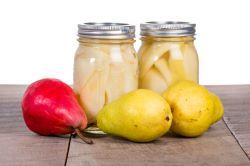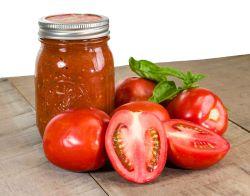Heat is transferred to the food by boiling water that surrounds the jars in a boiling water canner. Maintaining a temperature of 212°F for the time specified in a tested recipe is adequate to destroy molds, yeasts, spoilage enzymes, and some bacteria. Processing times are usually given for altitudes of 1,000 feet above sea level and lower. Higher altitudes need longer processing times. It is important to know your elevation before starting the canning process. Visit What is my elevation? for information on determining your altitude. You can also type in “What’s my elevation?” on your Smart phone’s search engine and it will give you the altitude for your exact location.
Altitude Adjustment: For altitudes of 1,001-3,000 ft. add 5 minutes to the processing time.
Following directions for hot or raw packing, pack fruit or acidified tomatoes into hot jars. Leave ½ inch head space except where indicated. Remove air bubbles. Wipe jar rims. Adjust lids. Process in a boiling water bath canner. Use a jar lift to place and remove jars from the canner, being careful not to tilt the jars in the process.
Anti-darkening Solution: Light colored fruits such as apples and pears will turn dark once cut or peeled. To prevent darkening, hold small batches of fruit in an ascorbic acid (Vitamin C) solution until ready to use. Mix one teaspoon or 3000 mg of ascorbic acid in one gallon of water. Commercially prepared mixes of ascorbic are also available where canning supplies are sold. Follow the manufacturer’s directions. Drain thoroughly before canning.

- Fill the canner half full of water. Preheat the water to 140°F for raw-packed foods and to 180°F for hot-packed foods.
- Place pre-filled jars upright on a rack in the canner. The water should be at least 1 inch above the tops of the jars. Add more hot water if necessary to cover the jars with at least 1 inch of water.
- Place the lid on the canner and keep covered during the entire process.
- Turn heat to its highest position until water boils vigorously; then lower the heat setting to maintain a gentle boil while processing for the recommended time.
- After processing for the correct amount of time based on altitude, turn off the heat and remove the canner from the burner, remove the canner lid, and let the jars rest in the canner for 5 minutes before removing them from the canner.

Apples, sliced
Preparation: An average of 19 pounds is needed per canner load of 7 quarts; an average of 12-1/4 pounds is needed per canner load of 9-pint jars. Wash, peel, core, and slice into ½ inch wedges. Place into anti-darkening solution. Drain slices prior to packing into jars.
Hot pack: Put 5 lbs. of apple slices in a pot with 2 cups of water, very light, light, or medium syrup. Boil for 5 minutes. Fill jars with hot slices and hot syrup or hot water, leaving a ½ inch headspace.
Jar size: Pint or Quarts
Processing Time in Boiling Water Canner (0 - 1000 ft): Pints or quarts: 20 minutes. Adjust for altitude if necessary.
Applesauce
Preparation: An average of 21 pounds is needed per canner load of 7 quarts; an average of 13½ pounds is needed per canner load of 9 pints. Wash, peel, core. Slice and place into anti-darkening solution. Drain slices.
Hot pack: Place sliced apples in large pot, add ½ cup water. Heat until tender. If desired, press through sieve for a smooth sauce. The sauce can remain chunky. Add 1/8 cup of sugar per quart or sugar to taste. Reheat applesauce and sugar to a boil. Applesauce can be packed without sugar. Fill jars with hot sauce, leaving ½ inch headspace. Adjust lids and process.
Jar size: Pints or Quarts
Processing Time in Boiling Water Canner (0 - 1000 ft): Pints 15 Minutes, quarts 20 Minutes. Adjust for altitude if necessary.
Berries (whole blackberries, blueberries, raspberries)
Preparation: Wash. Drain, cap, stem.
Hot pack: Blanch 1 pound of berries in 1-gallon of boiling water for 30 seconds, drain. Add ½ cup hot syrup, juice, or water to hot jars. Pack hot berries into hot jars. Fill with more hot cooking liquid, leaving a ½ inch headspace.
Jar size: Pints or Quarts
Processing Time in Boiling Water Canner (0 - 1000 ft): Pints or quarts 15 minutes. Adjust for altitude if necessary.
Fruit Purees of any fruit except bananas, Asian pears, figs, tomatoes, melons, papaya, ripe mango, or coconut. There are no home canning recommendations available for purees of these fruits.
Preparation: Stem, wash, drain, peel and remove pits.
Hot pack: Measure fruit into large pot, crushing slightly if desired. Add 1 cup hot water for each quart of fruit. Cook slowly until soft. Stir frequently. Press through sieve or food mill. If desired, add sugar to taste. Reheat until sugar dissolves. Fill hot puree into hot jars. Leave ¼ inch headspace.
Jar size: Pints or Quarts
Processing Time in Boiling Water Canner (0 - 1000 ft): Pints or quarts 15 minutes. Adjust for altitude if necessary.
Peaches
CAUTION: Do not use this process to can white-flesh peaches. There is evidence that some varieties of white-flesh peaches are higher in pH (i.e., lower in acid) than traditional yellow varieties. The natural pH of some white peaches can exceed 4.6, making them a low-acid food for canning purposes. Currently there is no low-acid pressure process available for white-flesh peaches nor a researched acidification procedure for safe boiling water canning. Freezing is the recommended method of preserving white-flesh peaches.
Preparation: To remove skins from peaches, dip in boiling water for 30-60 seconds until skins loosen. Dip in cold water. Slip off skins. Cut in half, remove pit and slice if desired. Place into anti-darkening solution. Drain.
Hot pack: Place in boiling juice, water, or syrup, bring to boil. Fill hot jars with hot fruit. Place halves in layers, cut side down. Fill jars with hot cooking liquid, leaving a ½ inch headspace.
Raw packs make poor quality peaches.
Jar size: Pints or Quarts
Processing Time in Boiling Water Canner (0 - 1000 ft): Pints 20 minutes, quarts 25 minutes. Adjust for altitude if necessary.
Pears, Halved
Preparation: An average of 17½ pounds is needed per canner load of 7 quarts; an average of 11 pounds is needed per canner load of 9 pints. Wash, peel. Cut lengthwise in half, remove core. Place into anti-darkening solution. Drain.
Hot pack: Boil pears for 5 minutes in syrup, juice, or water. Fill hot jars with hot fruit and hot cooking liquid, leaving a ½ inch headspace.
Jar size: Pints or Quarts
Processing Time in Boiling Water Canner (0 - 1000 ft): Pints 20 minutes, quarts 25 minutes. Adjust for altitude if necessary.
Plums, halved or whole
Preparation: Wash. To can whole, prick skin on two sides with fork. Freestone varieties may be halved and pitted.
Hot pack: Add plums to hot water or very light, light, or medium syrup. Boil for 2 minutes, cover saucepan, let stand 20-30 minutes. Fill hot jars with hot fruit and cooking liquid or syrup, leaving a ½ inch headspace.
Raw pack: Fill hot jars with raw plums, pack firmly. Fill with hot water or syrup, leaving a ½ inch headspace.
Jar size: Pints or Quarts
Processing Time in Boiling Water Canner (0 - 1000 ft): Pints 20 minutes, quarts 25 minutes. Adjust for altitude if necessary.
Rhubarb, stewed
Preparation: Select young, tender stalks. Trim off leaves. Wash, cut stalks into ½ to 1” pieces.
Hot pack: Add ½ cup sugar to each quart rhubarb and let stand until juice appears. Gently bring to a boil. Fill hot jars immediately, leaving a ½ inch headspace.
Jar size: Pints or Quarts
Processing Time in Boiling Water Canner (0 - 1000 ft): Pints or quarts 15 minutes. Adjust for altitude if necessary.
Tomatoes, crushed (with no added liquid)
Preparation: An average of 22 pounds is needed per canner load of 7 quarts; an average of 14 fresh pounds is needed per canner load of 9 pints. Wash tomatoes. Dip in boiling water 30-60 seconds or until skins split. Dip in cold water. Remove skins, core. Quarter.
Hot pack: Heat about 1 pound of the quarters quickly in large pot, crushing them with a spoon as they are added to the pot. Continue heating. Stir. Once boiling, gradually add remaining tomatoes, stir constantly. The remaining tomatoes don’t need to be crushed. Boil gently for 5 minutes. Add 2 tablespoons of bottled lemon juice or ½ teaspoon citric acid to each quart jar (1 tablespoon bottled lemon juice or ¼ teaspoon citric acid to each pint). Fill hot jars with hot tomatoes and cooking liquid, leaving ½ inch headspace. Optional: Add ½ teaspoon salt to each pint jar (1 teaspoon/quart) if desired.
Jar size: Pint or Quarts
Processing Time in Boiling Water Canner (0 - 1000 ft): pints 35 minutes, quarts 45 minutes. Adjust for altitude if necessary.
Tomatoes, whole or halved (packed in water)
Preparation: An average of 21 pounds is needed per canner load of 7 quarts; an average of 13 pounds is needed per canner load of 9 pints. Wash tomatoes. Dip in boiling water 30-60 seconds or until skins split. Dip in cold water. Remove skins, core. Leave whole or in halves.
Hot pack: Place prepared tomatoes in pot, cover with water, boil gently for 5 minutes. Add bottled lemon juice or citric acid to jars (see above). Fill hot jars with hot tomatoes and hot cooking liquid. Optional: Add ½ teaspoon salt to each pint jar (1 teaspoon/quart) if desired.
Raw pack: Add bottled lemon juice or citric acid to jars (see above). Optional: Add ½ teaspoon salt to each pint jar (1 teaspoon/quart) if desired. Pack prepared tomatoes into hot jars. Fill jars with boiling water.
Jar size: Pint or Quarts.
Processing Time in Boiling Water Canner (0 - 1000 ft*): Pints 40 minutes, quarts 45 minutes. Adjust for altitude if necessary.

Tomatoes have a pH value that falls close to 4.6. To ensure safe acidity levels in whole, crushed, or juiced tomatoes; add lemon juice or citric acid according to directions. This happens whether they will be processed in a boiling water canner or pressure canner.
For more detailed, research-based information on food preservation, go to the National Center for Home Food Preservation website.
For answers to your home food preservation questions, contact the UNH Extension Education Center and Infoline:
Ask Questions, Get Ideas
Staff experts, Master Gardeners and Natural Resource Stewards connect you with the resources of the University of New Hampshire.

